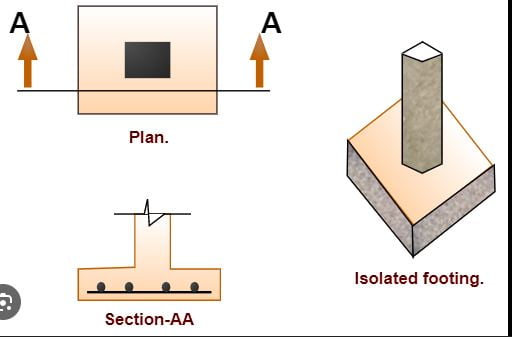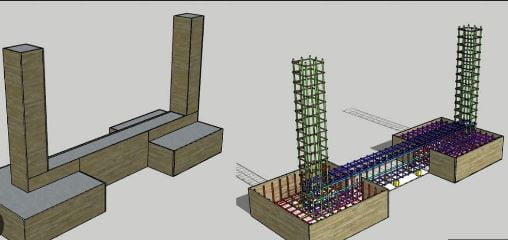
Are you going to build your new house, office, etc. and want to know about the different types of foundations for building? Then you are at the right place where you will get accurate information for your residential or commercial buildings. Our builders depict the structural view in front of you that will help you in choosing the right type of foundation in your building.
A strong base is very important in today’s era as everyone wants the best and safe foundation while building their houses and for this ARCHITECA is the leading construction company in Kanyakumari that offers the different types of foundations for houses.
Before discussing the types of foundations everyone must have knowledge about the “basic definition of the foundation”: Foundation describes in two ways i.e.
Definition with Types of Foundation in Civil Engineering
Where it means a component of a building that joins it to the ground and transfers load from the building to the ground. It is the application of soil mechanism and rock tool to design the foundational components of the building with shallow and deep foundations.
Definition with Types of Foundation in Construction
Where it means a lower structural part of the building that allocates its gravity loads to the ground. A big building must have a strong basis if it is a standpoint for a long period. It also considers the two types of foundation shallow foundation and deep foundation.
As you already read ARCHITECA’s previous blog post or webpage content like types of stairs, here in this blog our construction company in Nagercoil come up with new ideas and information about the types of foundation that is today’s most significant information for the users, builders, architectures those commence with new construction in the requisite area.
Foundations Depend on the Following Considerations
- Ground Environments.
- Presence of water in the desired area.
- Knows the load of the structure above the large area.
- Space requirement for the foundation settlement.
- Understanding the vibration and noise levels.
Benefits of A Strong Foundation:
When building a strong foundation, firmness is everything. More than just plot a house above the soil, it offers the following benefits:
- It supports the building.
- It repels the movement of soil beneath the building.
- It offers protection against cold.
- It prevents the destruction of any sort happening due to water or dampness.
Types of Foundation for Building by ARCHITECA
1. Shallow Foundations:

It is the foundation places nearby the surface of the ground which transmits the loads from deep shallow where the depth is about 3m less than its width where soil supports the structural loads. A shallow foundation is inexpensive, easy to build, requires less labor, and ARCHITECA Designers and Builders follow the simple process at an affordable cost. The only cons are that it is suitable for lightweight constructions because it is weak against sideways loads etc. The further types are as below:-
a) Individual/Isolated Foundation

The isolated footing is also known as Pad or spread footings that carry and spreads the intense loads either in rectangular form or in the square form on the single columns or pillars. These loads are depended upon the size or capacity of the soil used to make the basis of the building. It consists of a reinforced or non- reinforced material. If you want to spread the weight for reinforced foundation then the height has to be bigger in levels.
b) Combined Foundations

A combined footing works on two columns. It is useful when the two columns are very close to each other that connect their individual footings. A column is close to the boundary of the site that an isolated foundation will eccentrically load and where the basics of adjacent columns are linked to resisting uplift, spillover or opposition forces. A combined footing may be in rectangular or trapezoidal form.
C) Spread Foundations
The spread footing is also known as strip footing and wall footings. It works as a beam and applies the loads on the upward direction. The base is wider than the wall footings which help in spreading the weight from the building structure above the large areas to maintain the solidity. These footings use the single columns, walls and bridge pier where the levels of the soil from the earth shallow are about 10 feet.
D) Raft/Mat Foundations.
Mat footings are useful to carry the heavy loads of the building from the columns and walls. A mat is vital when the admissible soil pressure is low or where the columns and walls are very close that connects the individual footings. It is designed like the combined footings/single mat to bear the load of the building and fit for the spread-out soils. It is not suitable where the groundwater is above the surface of the soil.
2. Deep Foundations
Deep foundation is founded at the depth of the ground surface. This foundation transfers the loads from the surface areas which aha s weak soil or fills it in the strong or less compress soils or rocks deeply. It is expensive than shallow foundations and the process is very difficult. It requires more labor, skills and time-consuming task as it is not flexible. The further types are as below:-
a) Basement Foundations:
It consists of a full structural foundation wall that bears the footing run along the boundary of the basement. These foundations use the concrete slabs, crawl space to make the modern types of foundation for houses.
b) Pile Foundation
It is footing which transmits the heavy loads from the building to a hard soil that is deeper below the ground levels. This type of foundation protects the uplift of the buildings from the sideways loads like earthquakes and high storm winds.
c) Drill Shaft Foundations
It is also referred to as drilled piers, caissons, or bored piles that support the sideways loads by digging cylindrical shafts into the earth’s surface and fill with it concrete. It works similarly to the pile foundation but it handles the high capacity on the soil. It is useful where the hard rock/soil is deeper than the ground level from 10m to 100m.
d) Hollow box foundation
It is also known as Buoyancy rafts or floating foundation which is designed as a hollow box structure. It is useful where the soil of the surface is weak and soft to construct the building.
e) Cylinders Foundations
It is a small single cell caisson which is useful for water crossings and other aquatic applications the needs building basis with high load resistance to erosion.
Conclusion: –
In the end, we want to say that everyone is looking for the best foundations in their small to the large house that protects the inner and outer boundaries of the building.
If the bearing capacity of the soil is stronger and the building has smaller gaps with perfect angles then it less knocked over. If the foundation of the building is deep into the soil/rock then the structure of the building is not easily dumped with the smaller gaps between the building and the soil because height is joined into the soil. Therefore, smaller the angle means sturdier the surface of the building and deeper the foundation means sturdier the surface of the building.
So, don’t rush or confused for any other company just make your first call to our reputed and trustworthy company and take the services of our types of foundation in construction.
ARCHITECA – Construction Company in Nagercoil fulfills all your dreams and gives you the best types of foundations for houses.
There are varieties of types for foundation building when you search on various search engines and above are the few types that are very popular and commonly used in making a residential or commercial building that will help you in choosing the best one according to your house structure.
Our company offers quality materials for the foundation of building with our highly skilled builders in Nagercoil and never disappoint you and work as per your requirements.

